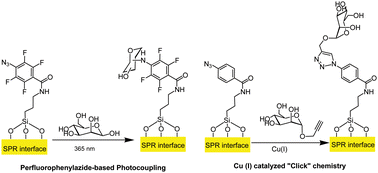Carbohydrate microarrays have become an important tool for studying glycan-cell interactions, carbohydrate-binding proteins, and in detecting dangerous pathogens. The current sensor methods require complex labeling or indirect analyte detection.
Using surface plasmon resonance spectroscopy (SPR), Sabine Szunerits and coworkers at Lille 1 University detected carbohydrate-binding protein complexes directly and without labels. In order to use SPR, they developed a unique substrate of Ti, Au, and silicon dioxide and tested two carbohydrate surface attachment chemistries. The azide-functionalized surfaces were linked to a glycan using a copper “click” chemistry or photocoupling. Both methods showed comparable binding efficiency and sensitivity of the carbohydrate binding protein.
To read the full article, click on the link below. It will be free to read until January 9th.
Comparison of photo- and Cu(I)-catalyzed “click” chemistries for the formation of carbohydrate SPR interfaces
Nazek Maalouli, Alexandre Barras, Aloysius Siriwardena, Mohamed Bouazaoui, Rabah Boukherroub and Sabine Szunerits
Analyst, 2013, Advance Article
DOI: 10.1039/C2AN36272D











